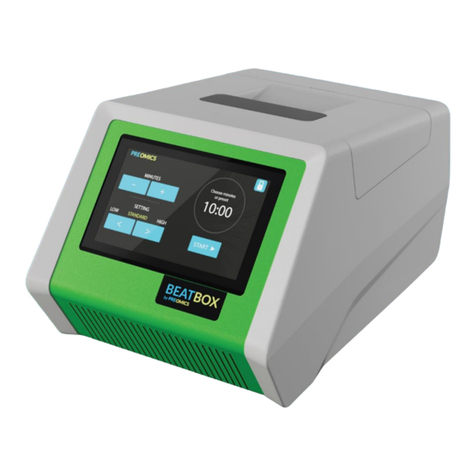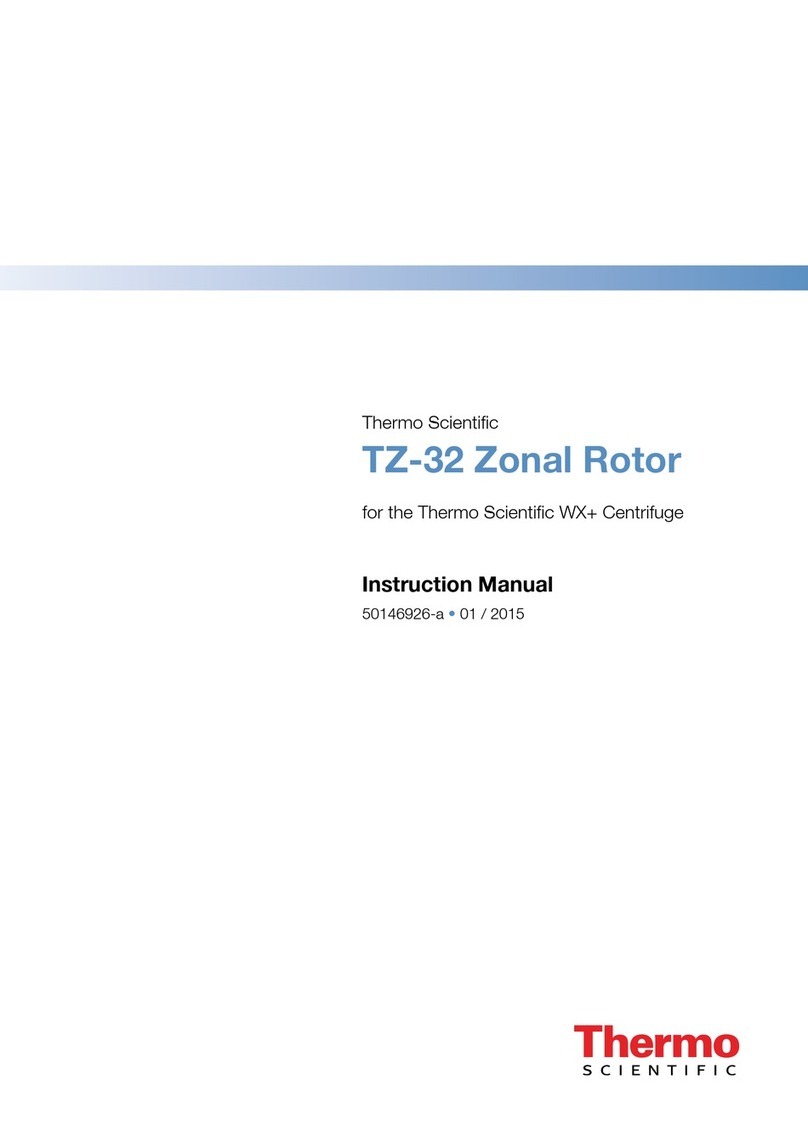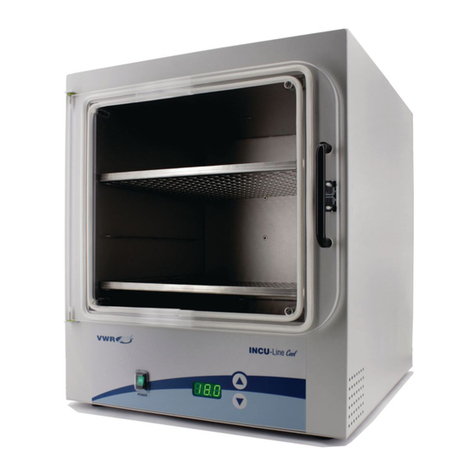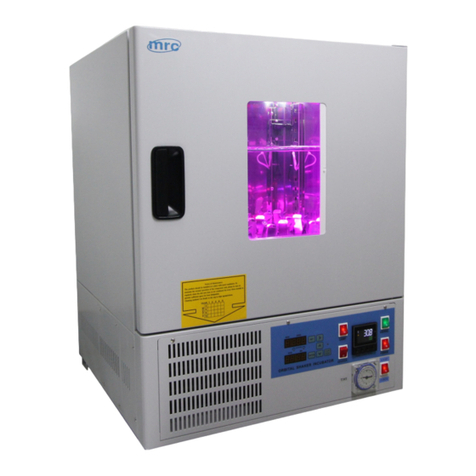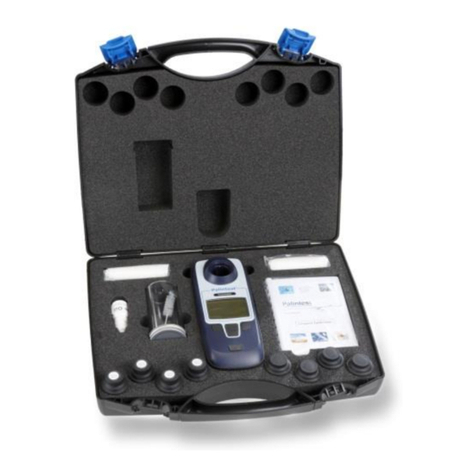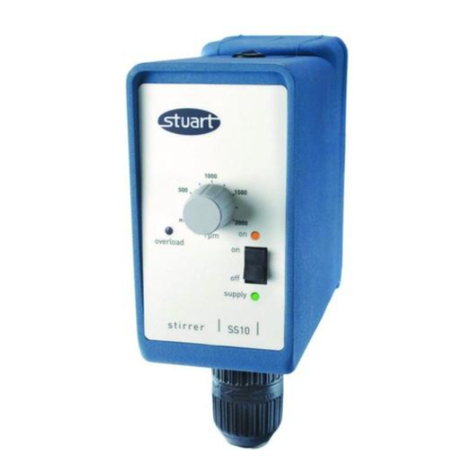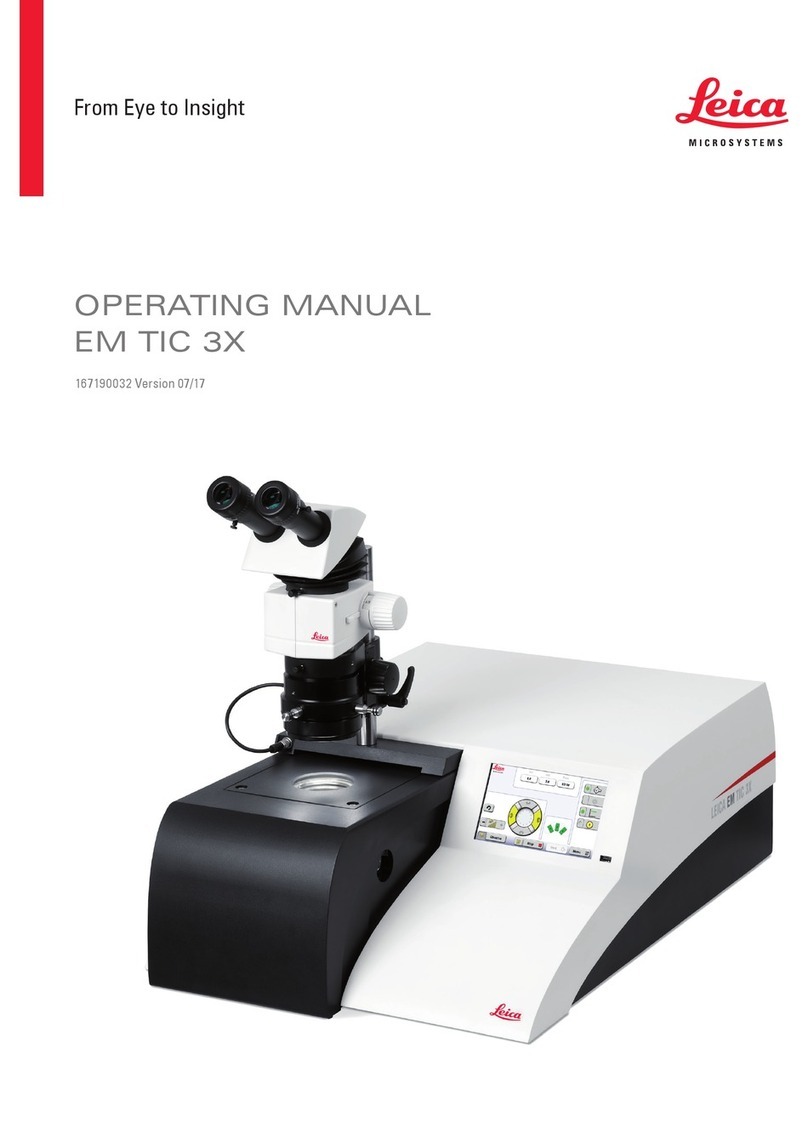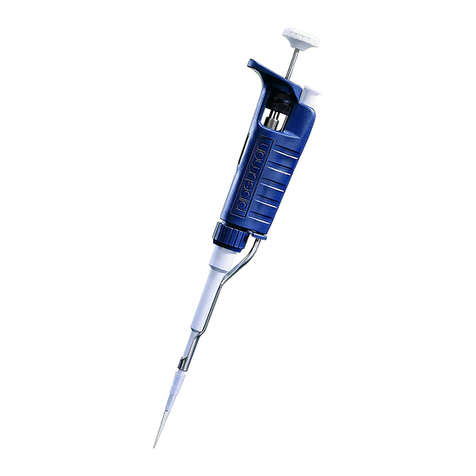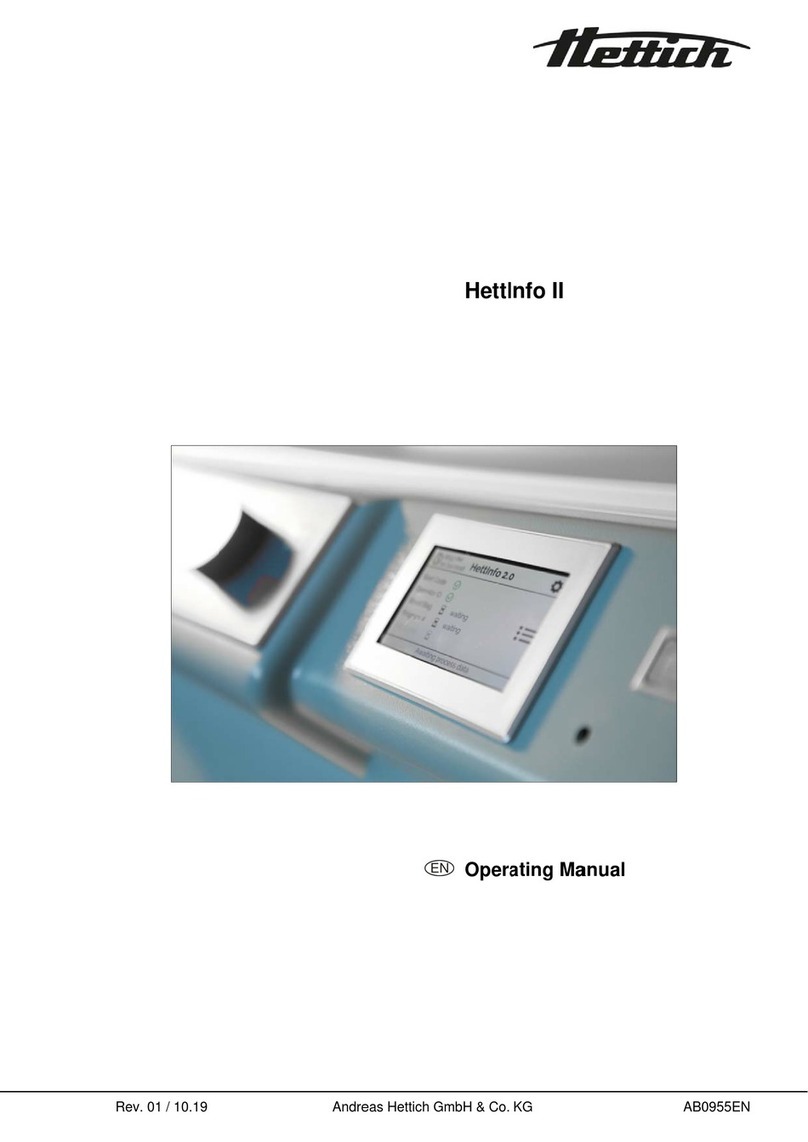PreOmics PreON User manual

Copyright © 2020 PreOmics GmbH

UM-PN-1001-02 1/136
Document Information
SUBJECT DESCRIPTION
PRODUCT: PreON
DOCUMENT TYPE: User Manual
DOCUMENT NAME: PreON User Manual
DOCUMENT NUMBER: UM-PN-1001
REVISION: 02
DATE: 20/02/2020
COMPANY: PreOmics GmbH
Document Change Control
Adaptations and updates of the present document are a consequence of technical improvements and
amendments of the PreON. Any changes within this document are to be controlled.
Document revisions
REVISION DOCUMENT FILE NAME REASON FOR CHANGE BYVALID FROM
01 SM-PN1001-01 New Document HSE 08/10/2019
02 SM-PN1001-02 Updates for SW 1.2 HSE 20/02/2020
Trademarks
Trademarks: PreON
© 2020 PreOmics GmbH, all rights reserved.

UM-PN-1001-02 2/136
Table of content
1Introduction ......................................................................................................................................... 7
1.1 About this user manual .................................................................................................... 7
1.1.1 Technical assistance change ...................................................................................... 8
1.1.2 Policy statement........................................................................................................... 8
1.2 Intended use of the PreON ............................................................................................ 8
1.3 Requirements for PreON users ...................................................................................... 8
2Safety Information.............................................................................................................................. 9
2.1 Proper use........................................................................................................................... 9
2.2 Electrical safety................................................................................................................11
2.3 Environment.....................................................................................................................12
2.3.1 Operating conditions.................................................................................................12
2.4 Biological safety...............................................................................................................13
2.4.1 Samples ........................................................................................................................13
2.5 Chemicals..........................................................................................................................13
2.5.1 Toxic fumes .................................................................................................................14
2.6 Waste disposal.................................................................................................................14
2.7 Mechanical hazards.........................................................................................................14
2.7.1 Centrifuge ....................................................................................................................15
2.8 Heat hazard ......................................................................................................................16
2.9 Maintenance safety.........................................................................................................16
2.10 Radiation safety ...............................................................................................................17
2.11 Symbols on the PreON...................................................................................................17
3General Description .........................................................................................................................18
3.1 External features of the PreON....................................................................................20
3.2 Internal features of the PreON.....................................................................................25
4Installation Procedures ....................................................................................................................31
4.1 Installation environment................................................................................................31
4.1.1 Site requirements.......................................................................................................31
4.1.2 Power requirements ..................................................................................................32
4.1.3 Grounding requirements...........................................................................................32
4.2 Installation of AC power cord.......................................................................................33
4.3 Unpacking the PreON ....................................................................................................33
4.4 Installing the PreON .......................................................................................................34
4.4.1 Remove PreON accessories.....................................................................................34
4.4.2 Remove the foam protector.....................................................................................34

UM-PN-1001-02 3/136
4.4.3 Installation of AC power cord..................................................................................34
4.4.4 Powering ON the PreON..........................................................................................35
4.4.5 Installing the centrifuge rotor and buckets...........................................................35
4.5 Configuration of the PreON..........................................................................................36
4.5.1 Setting basic system data .........................................................................................37
4.5.2 User settings................................................................................................................38
4.5.3 Managing users...........................................................................................................39
4.5.4 Changing password....................................................................................................42
4.5.5 Managing protocols ...................................................................................................43
4.5.6 Updating software .....................................................................................................45
4.6 Packing the PreON..........................................................................................................47
5Operating Procedures......................................................................................................................49
5.1 PreON software...............................................................................................................52
5.1.1 Entering text and numbers.......................................................................................53
5.2 Switching on the instrument and logging in...............................................................54
5.3 Setting up a protocol run...............................................................................................55
iST-NHS protocol.......................................................................................................................57
Step 1 Scan barcode chemical labeling reagent...................................................................57
Step 2 Select sample type ........................................................................................................57
Step 3 Select digestion duration .............................................................................................58
Step 4 Select number of samples............................................................................................58
Step 5 Select chemical labeling plex degree.........................................................................58
Step 6 Select amount of chemical labeling reagent ............................................................59
Step 7 Chemical labeling options............................................................................................59
Step 8 Load chemical labels .....................................................................................................59
Step 9 Load reagents.................................................................................................................60
Step 10 Load tip racks...............................................................................................................60
Step 11 Load the centrifuge rotor adapter...........................................................................60
Step 12 Load shaker ..................................................................................................................61
iST protocol .................................................................................................................................62
Step 1 Select sample type ........................................................................................................62
Step 2 Select digestion duration .............................................................................................62
Step 3 Select number of samples............................................................................................62
Step 4 Load reagents.................................................................................................................63
Step 5 Load tip racks .................................................................................................................63
Step 6 Load the centrifuge rotor adapter..............................................................................63

UM-PN-1001-02 4/136
Step 7 Load shaker.....................................................................................................................64
5.3.1 Loading reagents and tips.........................................................................................64
5.3.2 Loading the centrifuge ..............................................................................................65
5.3.3 Loading the shaker.....................................................................................................68
5.4 Starting the protocol run................................................................................................69
5.5 End of the protocol run..................................................................................................70
5.6 Stopping a protocol run..................................................................................................70
5.7 Saving run reports to the USB stick.............................................................................71
5.8 Logging out.......................................................................................................................71
6Maintenance Procedures ................................................................................................................72
6.1 Cleaning agents................................................................................................................72
6.1.1 Disinfection .................................................................................................................73
6.2 Servicing............................................................................................................................74
6.3 Regular maintenance procedure ..................................................................................75
6.4 Daily maintenance procedure.......................................................................................76
6.5Monthly maintenance procedure.................................................................................77
6.6 Periodic maintenance procedure .................................................................................77
6.6.1 Cleaning the robotic arm modules..........................................................................78
6.6.2 Cleaning the centrifuge.............................................................................................78
6.6.3 Tightness test..............................................................................................................82
O-Ring exchange........................................................................................................................83
6.7 Decontaminating the PreON ........................................................................................87
7Troubleshooting................................................................................................................................88
7.1 General information........................................................................................................88
7.2 Contacting PreOmics Technical Services ...................................................................88
7.2.1 Creating a support package......................................................................................88
7.3 Operation..........................................................................................................................89
7.3.1 Protocol interruption.................................................................................................90
7.3.2 Centrifuge....................................................................................................................91
7.3.3 Reagent volume detection and ultrasonic pipe....................................................93
7.3.4 Touchscreen................................................................................................................93
8Glossary ..............................................................................................................................................96
9Appendix A – Technical data..........................................................................................................98
9.1 Operating conditions ......................................................................................................98
9.2 Transport conditions.......................................................................................................98
9.3 Storage conditions...........................................................................................................98

UM-PN-1001-02 5/136
9.4 Mechanical data and hardware features ....................................................................98
9.5 Declaration of Conformity.............................................................................................99
9.6Waste Electrical and Electronic Equipment (WEEE) ..............................................100
9.7 FCC Declaration ..........................................................................................................100
9.8 Liability Clause ...............................................................................................................101
10 Appendix B – PreON Accessories...............................................................................................102
11 Appendix C – Consignes de sécurité ..........................................................................................103
11.1 Utilisation appropriée...................................................................................................103
11.2 Sécurité électrique ........................................................................................................105
11.3 Atmosphère ....................................................................................................................106
11.4 Sécurité biologique........................................................................................................106
11.4.1 Échantillons ...............................................................................................................106
11.5 Produits chimiques........................................................................................................107
11.5.1 Vapeurs toxiques......................................................................................................107
11.6 Traitement des déchets................................................................................................108
11.7 Dangers mécaniques.....................................................................................................108
11.7.1 Centrifuge..................................................................................................................109
11.8 Dangers liés à la chaleur...............................................................................................110
11.9 Sécurité relative à la maintenance .............................................................................110
11.10 Sécurité contre les rayonnements .............................................................................111
11.11 Symboles sur le PreON ................................................................................................112
12 Appendix D – Sicherheitshinweise..............................................................................................113
12.1 Sachgemäße Handhabung...........................................................................................113
12.2 Schutz vor Stromschlag................................................................................................115
12.3 Atmosphären..................................................................................................................117
12.3.1 Operating conditions...............................................................................................117
12.4 Biologische Sicherheit ..................................................................................................117
12.4.1 Proben ........................................................................................................................117
12.5 Chemikalien ....................................................................................................................118
12.5.1 Giftige Dämpfe .........................................................................................................118
12.6 Entsorgen von Abfällen................................................................................................119
12.7 Gefahren durch mechanische Teile ...........................................................................119
12.7.1 Zentrifuge ..................................................................................................................120
12.8 Hitzegefahr .....................................................................................................................121
12.9 Sicherheitshinweise – Wartungsarbeiten.................................................................121
12.10 Strahlensicherheit..........................................................................................................122

UM-PN-1001-02 6/136
12.11 Symbols on the PreON.................................................................................................122
13 Appendix E – Informazioni di sicurezza......................................................................................124
13.1 Uso corretto ...................................................................................................................124
13.2Sicurezza elettrica .........................................................................................................126
13.3 Ambiente.........................................................................................................................127
13.3.1 Condizioni d'uso .......................................................................................................127
13.4 Sicurezza biologica ........................................................................................................127
13.4.1 Campioni ....................................................................................................................128
13.5 Prodotti chimici..............................................................................................................128
13.5.1 Fumi tossici................................................................................................................129
13.6 Smaltimento dei rifiuti ..................................................................................................129
13.7 Pericoli di natura meccanica........................................................................................129
13.7.1 Centrifuga ..................................................................................................................130
13.8 Rischio di ustioni............................................................................................................131
13.9 Il piano di lavoro PreON contiene un agitatore riscaldato....................................131
13.10 Sicurezza nella manutenzione.....................................................................................131
13.11 Sicurezza dalle radiazioni .............................................................................................132
13.12 Simboli sul PreON .........................................................................................................133
14 Version history ................................................................................................................................134

UM-PN-1001-02 7/136
1Introduction
Thank you for choosing the PreON. We are confident it will become an integral part of your laboratory. Before using
the PreON, it is essential that you read this user manual carefully and pay attention to the safety information. The
instructions and safety information in the user manual must be followed to ensure safe operation of the instrument
and to maintain the instrument in a safe condition.
Only professionals who understand the user manual in the introduction and safety information section must operate
the device.
Seuls les professionnels qui comprennent le manuel d'utilisation dans la section introduction et informations de
sécurité doivent utiliser l'appareil.
Nur Fachleute, die das Benutzerhandbuch im Abschnitt Einführung und Sicherheitshinweise verstehen, dürfen das
Gerät bedienen.
Solo i professionisti che comprendono il manuale d'uso nella sezione introduzione e informazioni sulla sicurezza
devono utilizzare l'apparecchio.
1.1 About this user manual
This user manual provides information about the PreON in the following sections:
1. Introduction
2. Safety Information
3. General Description
4. Installation Procedures
5. Operating Procedures
6. Maintenance Procedures
7. Troubleshooting
8. Glossary
9. Appendix A – Technical data
10. Appendix B – PreON Accessories
11. Appendix C – Consignes de sécurité (Safety Information in French)
12. Appendix D – Sicherheitshinweise (Safety Information in German)
13. Appendix E – Informazioni di sicurezza (Safety Information in Italian)

UM-PN-1001-02 8/136
1.1.1 Technical assistance change
At PreOmics, we pride ourselves on the quality and availability of our technical support. Our Technical Services
Departments are staffed by experienced scientists with extensive practical and theoretical expertise in molecular
biology and the use of PreOmics products. If you have any questions or experience any difficulties regarding the
PreON or PreOmics products in general, do not hesitate to contact us.
PreOmics customers are a major source of information regarding advanced or specialized uses of our products. This
information is helpful to other scientists as well as to the researchers at PreOmics We therefore encourage you to
contact us if you have any suggestions about product performance or new applications and techniques.
For technical assistance and more information, please call one of the PreOmics Technical Service Departments or
local distributors (see back cover or visit www.preomics.com).
1.1.2 Policy statement
It is the policy of PreOmics to improve products as new techniques and components become available. PreOmics
reserves the right to change specifications at any time.
To produce useful and appropriate documentation, we appreciate your comments on this user manual. Please
contact PreOmics Technical Services.
1.2 Intended use of the PreON
The PreON is designed to perform fully automated purification of peptides and proteins in molecular biology
applications. The system is intended for use by professional users, such as technicians and physicians trained in
molecular biological techniques and the operation of the PreON. The PreON system is not intended for diagnostic
use.
The PreON is intended to be used only in combination with PreOmics kits indicated for use with the PreON for the
applications described in the kit handbooks.
1.3 Requirements for PreON users
The table below covers the general level of competence and training necessary for transportation, installation, use,
maintenance, and servicing of the PreON.
Task
Personnel
Training and experience
Transportation
No special requirements
No special requirements
Storage
No special requirements
No special requirements
Routine use and maintenance
Laboratory technicians or
equivalent
Professional personnel, such as
technicians and physicians, who are
trained in molecular biological
techniques and in the operation of
the proton.
Installation and servicing
PreOmics Field Service Specialists
only
Trained and authorized by PreOmics

UM-PN-1001-02 9/136
2Safety Information
Before using the PreON, it is essential that you read this user manual carefully and pay attention to the safety
information. The instructions and safety information in the user manual must be followed to ensure safe operation
of the instrument and to maintain the instrument in a safe condition. Note: Translations of the Safety Information
in French, German and Italian are available in Appendix C – Consignes de sécurité, Appendix D – Sicherheitshinweise
and Appendix E – Informazioni di sicurezza.
The following types of safety information appear in this manual.
WARNING
The term WARNING is used to inform you about situations that could result in personal
injury to you or other persons.
Details about these circumstances are given in a box like this one.
CAUTION
The term CAUTION is used to inform you about situations that could result in damage to
the instrument or other equipment.
Details about these circumstances are given in a box like this one.
Important note: All symbols that are marked on the PreON are explained in detail in the related sections of this
user manual. In particular it is mandatory to consult the user manual in case of the generic symbol shown below and
all specific symbols that are safety related.
Safety related information. User manual must be consulted to find out the nature of
potential hazards and any actions which have to be taken to avoid them
The advice given in this manual is intended to supplement, not supersede, the normal safety requirements prevailing
in the user’s country.
2.1 Proper use
WARNING Risk of personal injury and material damage
[W1]
Improper use of the PreON may cause personal injuries or damage to the instrument. The
PreON must only be operated by professional personnel who have been appropriately
trained.
Servicing of the PreON must only be performed by a PreOmics Field Service specialist.
Perform the maintenance as described in section Maintenance Procedures. PreOmics charges for repairs that are
required due to incorrect maintenance.

UM-PN-1001-02 10/136
WARNING
Risk of personal injury and material damage
[W2]
The PreON is too heavy to be lifted by one person. To avoid personal injury or damage to the
instrument, do not lift the instrument alone.
WARNING
Risk of personal injury and material damage
[W3]
Do not attempt to move the PreON during operation.
CAUTION
Damage to the instrument
[C1]
Avoid spilling water or chemicals onto the PreON. Damage caused by water or chemical
spillage will void your warranty.
In case of emergency, power OFF the PreON at the power switch located in front of the instrument and unplug the
power cord from the power outlet.
CAUTION
Damage to the instrument
[C2]
Only use PreOmics spin column-based cartridges and PreON specific consumables with the
PreON. Damage caused by use of other types of spin column-based cartridges or chemistries
will void your warranty.
WARNING
Risk of personal injury and material damage
[W4]
Do not use damaged rotor adapters. The rotor adapters can only be used once. High g forces
exerted in the centrifuge can cause damage to re-used rotor adapters.
CAUTION
Damage to the instrument
[C3]
Empty the tip disposal container prior to use to prevent a tip jam in the waste drawer. Failure
to empty the waste container may block the robotic arm that could cause run failure or
instrument damage.
WARNING
Risk of personal injury and material damage
[W5]
To prevent plastic crash, load the tubes properly. After a plastic crash, sharp plastic particles
could be inside the centrifuge. Be careful when handling items inside the centrifuge.
CAUTION
Damage to the instrument
[C4]
Only use the correct volume of liquids.
Exceeding the recommended volume of liquids may damage the centrifuge rotor or
instrument.

UM-PN-1001-02 11/136
WARNING
Risk of fire or explosion
[W6]
When using flammable liquids on the PreON (Acetonitrile, Isopropyl alcohol), handle such
liquids carefully and in accordance with the required safety regulations. If liquid has been
spilled, wipe it off and leave the PreON hood open to allow flammable vapors to disperse.
WARNING
Risk of fire or explosion
[W7]
The PreON is intended for use with reagents and substances supplied with PreOmics kits.
Use of other reagents and substances may lead to fire or explosion.
If hazardous material is spilled on or inside the PreON, the user is responsible for carrying out appropriate
decontamination.
CAUTION
Damage to the instrument
[C5]
Avoid contact of the reagents with the instrument surfaces and centrifuge (rotor, buckets,
gasket) as this will damage instrument surfaces and centrifuge gasket and cause corrosion of
metal on the worktable, the centrifuge rotor and buckets.
Clean spillage on the worktable and centrifuge immediately after the run.
Note: Do not place items on top of the PreON hoods.
CAUTION
Damage to the instrument
[C6]
Do not lean against the touchscreen when it is pulled out.
2.2 Electrical safety
Note: Disconnect the line power cord from the power outlet before servicing.
WARNING
Electrical hazard
[W8]
Any interruption of the protective conductor (earth/ground lead) inside or outside the
instrument or disconnection of the protective conductor terminal is likely to make the
instrument dangerous.
Intentional interruption is prohibited.
Lethal voltages inside the instrument
When the instrument is connected to line power, terminals may be live and opening covers
or removing parts is likely to expose live parts.

UM-PN-1001-02 12/136
WARNING
Damage to electronics
[W9]
Before powering ON the instrument, make sure that the correct supply voltage is used.
Use of incorrect supply voltage may damage the electronics.
To check the recommended supply voltage, refer to the specifications indicated in the
type plate of the instrument.
WARNING
Risk of electric shock
[W10]
Do not open any panels on the PreON.
Risk of personal injury and material damage may occur.
Only perform maintenance that is specifically described in this user manual.
To ensure satisfactory and safe operation of the PreON, follow these guidelines:
The line power cord must be connected to a line power outlet that has a protective conductor (earth/ground).
Do not adjust or replace internal parts of the instrument.
Do not operate the instrument with any covers or parts removed.
If the instrument becomes electrically unsafe, prevent other personnel from operating it, power OFF the instrument,
disconnect it from the power outlet and contact PreOmics Technical Services.
The instrument may be electrically unsafe when:
It or the line power cord appears to be damaged.
It has been stored under unfavorable conditions (see chapter 9.3 Storage conditions) for a prolonged period.
It has been subjected to severe transport stresses. Indications can be that the transportation crate is damaged,
or the instrument housing is compromised.
Liquids come in contact directly with electrical components of the PreON.
2.3 Environment
2.3.1 Operating conditions
WARNING Explosive atmosphere
[W11]
The PreON is not designed for use in an explosive atmosphere.
CAUTION
Damage to the instrument
[C7]
Direct sunlight may bleach parts of the instrument and cause damage to plastic parts.
The PreON must be located out of direct sunlight.

UM-PN-1001-02 13/136
2.4 Biological safety
Specimens and reagents containing materials from humans should be treated as potentially infectious. Use safe
laboratory procedures as outlined in publications such as Biosafety in Microbiological and Biomedical Laboratories,
HHS (www.cdc.gov/labs/pdf/CDC-BiosafetyMicrobiologicalBiomedicalLaboratories-2009-P.PDF).
2.4.1 Samples
Samples may contain infectious agents. You should be aware of the health hazard presented by such agents and
should use, store, and dispose of such samples according to the required safety regulations.
WARNING
Samples containing infectious agents
[W12]
Some samples used with this instrument may contain infectious agents. Handle such samples
with the greatest of care and in accordance with the required safety regulations.
Always wear safety glasses, 2 pairs of gloves, and a lab coat.
The responsible body (e.g., laboratory manager) must take the necessary precautions to ensure
that the surrounding workplace is safe, and that the instrument operators are suitably trained
and not exposed to hazardous levels of infectious agents as defined in the applicable Safety
Data Sheets (SDSs) or OSHA1or ACGIH2or documents.
Venting for fumes and disposal of wastes must be in accordance with all national, state, and
local health and safety regulations and laws.
2.5 Chemicals
WARNING
Hazardous chemicals
[W13]
Some chemicals used with this instrument may be hazardous or may become hazardous after
completion of the protocol run.
Always wear safety glasses, gloves, and a lab coat.
The responsible body (e.g., laboratory manager) must take the necessary precautions to
ensure that the surrounding workplace is safe and that the instrument operators are not
exposed to hazardous levels of toxic substances (chemical or biological) as defined in the
applicable Safety Data Sheets (SDSs) or OSHA or ACGIH documents.
Venting for fumes and disposal of wastes must be in accordance with all national, state, and
local health and safety regulations and laws.
CAUTION
Damage to the instrument
[C8]
Avoid contact of the reagents with the instrument surfaces and centrifuge (rotor, buckets,
gasket) as this will damage instrument surfaces and centrifuge gasket and cause corrosion
of metal on the worktable, the centrifuge rotor and buckets.
Clean spillage on the worktable and centrifuge immediately after the run.
1OSHA : Occupational Safety and Health Administration (United States of America).
2ACGIH : American Conference of Government Industrial Hygienists (United States of America).

UM-PN-1001-02 14/136
2.5.1 Toxic fumes
If working with volatile solvents or toxic substances, you must provide an efficient laboratory ventilation system to
remove vapors that may be produced.
WARNING
Vapors from volatile solvents
[W14]
Some of the solvents used with the instrument are volatile. Use the instrument only with
adequate ventilation according to the applicable Safety Data Sheets (SDSs) or OSHA or
ACGIH†documents.
WARNING
Toxic fumes
[W15]
Do not use bleach to clean or disinfect the PreON. Bleach in contact with salts from the
buffers can produce toxic fumes.
WARNING
Toxic fumes
[W16]
Do not use bleach to disinfect used labware. Bleach in contact with salts from the buffers
used can produce toxic fumes.
2.6 Waste disposal
Used labware, such as sample tubes, PreOmics spin column-based cartridges, filter-tips, buffer bottle and enzyme
tubes, or rotor adapters, may contain hazardous chemicals or infectious agents from the purification process. These
hazardous wastes must be collected and disposed of properly according to local safety regulations.
For more information about how to dispose of the PreON, see section 9.6 Waste Electrical and Electronic
Equipment (WEEE).
WARNING
Hazardous chemicals and infectious agents
[W17]
The waste may contain toxic material and must be disposed of properly. Refer to your local
safety regulations for proper disposal procedures.
2.7 Mechanical hazards
The hood of the PreON must remain closed during operation of the instrument. Only open the hood when instructed
to do so by the instruction for use.
While loading the worktable, always stand clear of the instrument. Do not lean on the worktable when the robotic
arm of the instrument is moving to reach loading position with its lid open. Wait until the robotic arm completed its
movements before you start to load or unload.

UM-PN-1001-02 15/136
WARNING
Moving parts
[W18]
Avoid contact with moving parts during operation of the PreON. Under no circumstances should
you place your hands under the robotic arm when it is lowering. Do not attempt to move any
tip racks or tubes whilst the instrument is operating.
WARNING
Moving parts
[W19]
To avoid contact with moving parts during operation of the PreON, the instrument must be
operated with the hood closed.
If the hood sensor or lock is not functioning correctly, contact PreOmics Technical Services.
2.7.1 Centrifuge
Make sure that the rotor and buckets are installed correctly. All buckets must be mounted before starting a protocol
run, regardless of the number of samples to be processed. If the rotor or buckets show signs of mechanical damage
or corrosion, do not use the PreON; contact PreOmics Technical Services.
CAUTION
Damage to the instrument
[C9]
The PreON must not be used if the centrifuge lid is broken, or if the lid lock is damaged.
Make sure that no loose material is inside the centrifuge during operation.
Make sure that the rotor is installed correctly and that all buckets are properly mounted,
regardless of the number of samples to be processed. Load the rotor only as instructed by the
software.
Only use rotors, buckets, and consumables designed for use with the PreON. Damage caused
by use of other consumables will void your warranty.
We recommend replacing the centrifuge after 20,000 cycles, which is equivalent to 9 years of
usage with two runs per day for 220 days each year. For more information contact PreOmics
Technical Services.
In case of breakdown caused by power failure, the centrifuge lid can be opened manually to remove the samples
(see section 7.3.2).
Cleaning and decontamination may be necessary as a safeguard before LABORATORY, CENTRIFUGES, ROTORS,
and any accessories are maintained, repaired, or transferred.
Manufacturers may provide a format for users to document that such treatment has been carried out. For more
information contact PreOmics Technical Services.
WARNING
Moving parts
[W20]
In case of breakdown caused by power failure, remove the power cord and wait 10 minutes
before attempting to manually open the centrifuge lid.

UM-PN-1001-02 16/136
CAUTION
Damage to the instrument
[C10]
After a power failure, do not move the z-module (robotic arm) manually. Damage may occur if
the centrifuge lid is closed and collides with the z-module.
WARNING
Risk of personal injury and material damage
[W21]
Raise the centrifuge lid carefully. The lid is heavy and may cause injury if it falls.
CAUTION
Risk of overheating
[C11]
To ensure proper ventilation, maintain a minimum clearance of 10 cm at the sides and rear of
the PreON.
Slits and openings that ensure the ventilation of the PreON must not be covered.
2.8 Heat hazard
The PreON worktable contains a heated shaker.
WARNING
Hot surface
[W
The shaker can reach temperatures of up to 70°C (158°F). Avoid touching it when it is hot.
Carefully remove the samples after a run.
2.9 Maintenance safety
WARNING/
CAUTION
Risk of personal injury and material damage
[W23]
Only perform maintenance that is specifically described in this user manual.
WARNING
Risk of explosion
[W2
4
When cleaning the PreON with alcohol-based disinfectant, leave the PreON hood open to
allow flammable vapors to disperse.
Only clean the PreON when worktable components have cooled down.
WARNING
Risk of fire
[W25]
Do not allow cleaning fluid or decontamination agents to come into contact with the electrical
parts of the PreON.

UM-PN-1001-02 17/136
WARNING
Risk of personal injury and material damage
[W26
]
To prevent the rotor nuts from loosening during operation of the centrifuge, securely tightened
the nuts using the rotor key supplied with PreON.
WARNING
Risk of personal injury and material damage
[W27]
Make sure that lids from spin column-based cartridges and 1.5 ml microcentrifuge tubes are in
the correct position and pushed all the way down to the bottom of the slots on the sides of the
rotor adapter. Incorrectly positioned lids can break off during centrifugation.
WARNING
Risk of personal injury and material damage
[W28]
Be sure the lid is completely removed from the spin column. Spin column-based cartridges with
partially removed lids may not be removed properly from the rotor, causing the protocol run to
crash.
CAUTION
Damage to the instrument
[C1
2
Do not use bleach, solvents, or reagents containing acids, alkalis or abrasives to clean
PreON.
CAUTION
Damage to the instrument
[C13
]
Avoid contact of the reagents with the instrument surfaces and centrifuge (rotor, buckets,
gasket) as this will damage instrument surfaces and centrifuge gasket and cause corrosion of
metal on the worktable, the centrifuge rotor and buckets.
Clean spillage on the worktable and centrifuge immediately after the run.
CAUTION
Damage to the instrument
[C14]
Do not use spray bottles containing alcohol or disinfectant to clean surfaces of the PreON.
Spray bottles should be used only to clean items that have been removed from the worktables.
2.10 Radiation safety
WARNING
Risk of personal injury
[W29]
Hazard Level 2 laser light: Do not stare into the light beam when using handheld bar code
scanner, Read for further instructions the user manual of the handheld scanner.
2.11 Symbols on the PreON
Symbol
Location
Description
Next to the shaker Hot surface – the temperature of the
shaker can reach up to 70ºC (158ºF)
(cf. section 2.8)

UM-PN-1001-02 18/136
Symbol
Location
Description
Near the centrifuge; near the
robotic arm Safety related information. User
manual must be consulted to find out
the nature of potential hazards and any
actions which have to be taken to
avoid them
Mechanical hazard — avoid contact
with moving parts (cf. section 2.7).
On the instrument, near bottle
rack Safety related information. User
manual must be consulted to find out
the nature of potential hazards and any
actions which have to be taken to
avoid them
Fire hazard – usage of ethanol in bottle
rack (cf. section 2.1).
In front of worktable
Inside the waste drawer
Biohazard risks – substances in the
waste drawer or used with this
instrument may be hazardous. based
on biological activity must be handled
with gloves (cf. section 2.4).
Back of the instrument next to
the mains connection
Possibility of electric shock. Do not
open any panels on the PreON (cf.
section 2.2)
Front of Barcode- scanner Laser radiation - do not stare into the
light beam (cf. 2.10)
Type plate on the back of the
instrument
CE marking to indicate conformity with
the applicable requirements of the
European Community
Type plate at the back of the
instrument
CSA marking to indicate compliance to
applicable CSA and ANSI/UL
Standards, for use in Canada and the
U.S..
Type plate on the back of the
instrument
Waste Electrical and Electronic
Equipment (WEEE) marking for Europe
to indicate that product must not be
disposed of with other waste (cf.
section 9.6)
Type plate on the back of the
instrument
Manufacturer
Type plate on the back of the
instrument
Serial number of the instrument
3General Description
The PreON performs fully automated processing of up to 12 samples. The PreON is designed to automate selected
PreOmics kits. The PreON controls integrated components, including a centrifuge, heated shaker, pipetting system
and robotic gripper.

UM-PN-1001-02 19/136
The PreON is preinstalled with iST and iST-NHS protocols for processing PreOmics spin column-based cartridges
for sample preparation and peptide cleanup. The user selects a protocol using the touchscreen and loads labware,
samples, and reagents onto the PreON worktable. The user then closes the instrument hood and starts the protocol,
which provides all necessary commands for sample lysis and purification using PreOmics spin column-based
cartridges. A fully automated load check helps to ensure correct loading of the worktable.
The range of protocols available is continually expanding.
PreON principle
Sample preparation using the PreON follows the same steps as the manual procedure (i.e., lyse, proteolytically
digest, wash and elute). No change in purification chemistry is required as you simply continue to use trusted
PreOmics kits.
1. Samples are lysed in the heated orbital shaker.
2. Each lysate is digested with Proteases added to the lysate by the PreON. Digestion reaction is stopped.
3. Each lysate protease mix is transferred to a spin column-based spin column-based cartridge in a rotor adapter.
4. Peptides bind to the membrane. During washing steps of the PreOmics spin column-based spin column-based
cartridge salts and contaminants are removed.
5. The spin column-based cartridge is transferred to a microcentrifuge tube for elution of purified peptides.
For an example workflow using a PreOmics iST Kit, see the flowchart below.
Table of contents
Other PreOmics Laboratory Equipment manuals
Popular Laboratory Equipment manuals by other brands
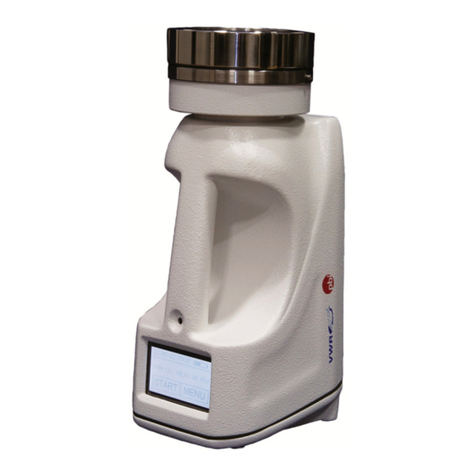
VWR
VWR SAS Super ISO instruction manual

Brouwland
Brouwland ENOLMATIC manual
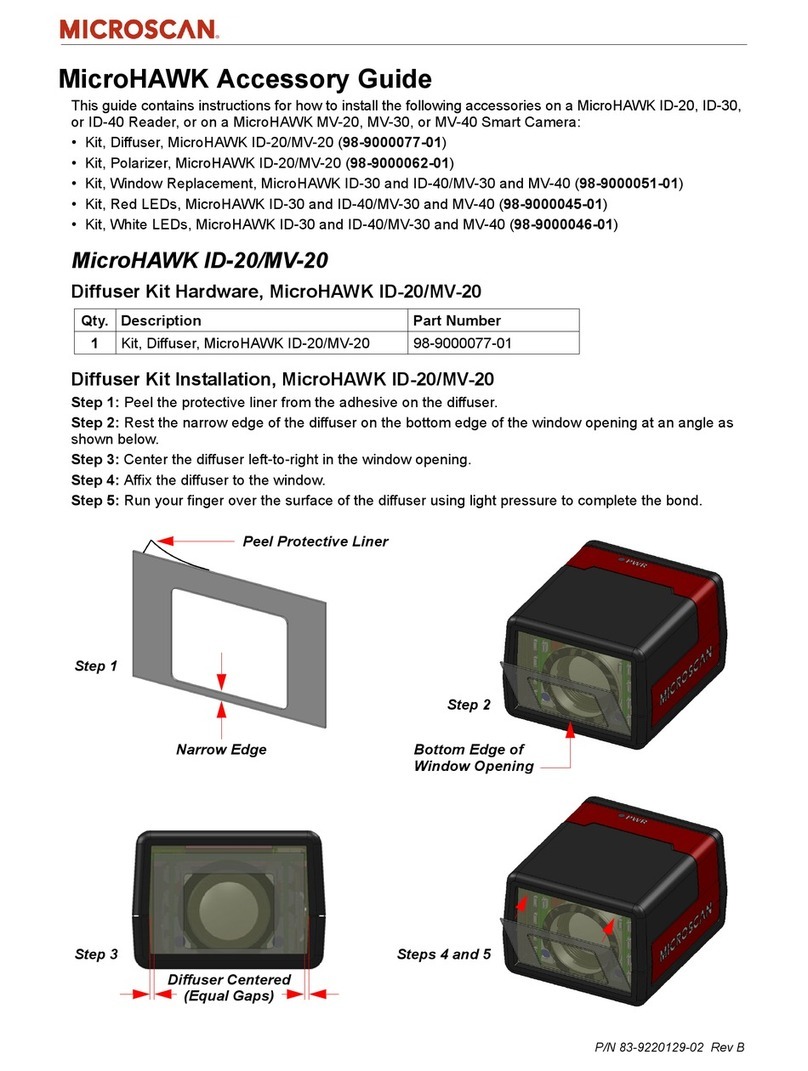
Microscan
Microscan MicroHAWK 98-9000077-01 Accessory guide
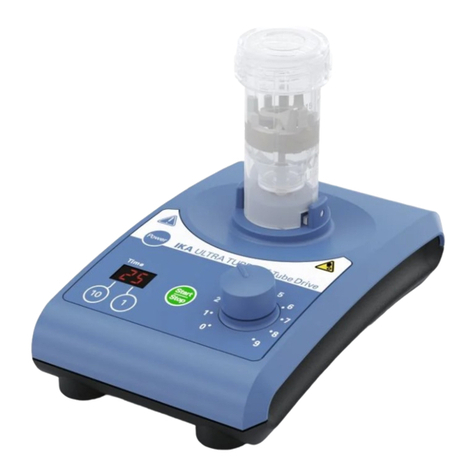
IKA
IKA ULTRA -TURRAX Tube Drive operating instructions
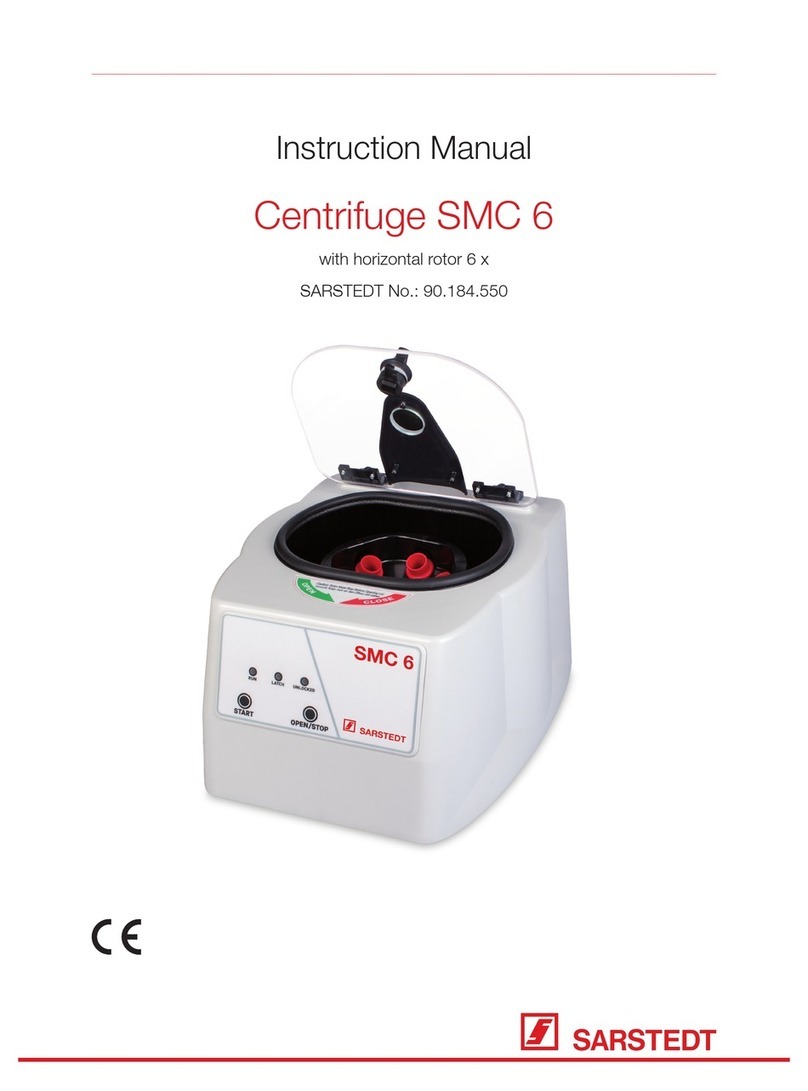
Sarstedt
Sarstedt SMC 6 instruction manual
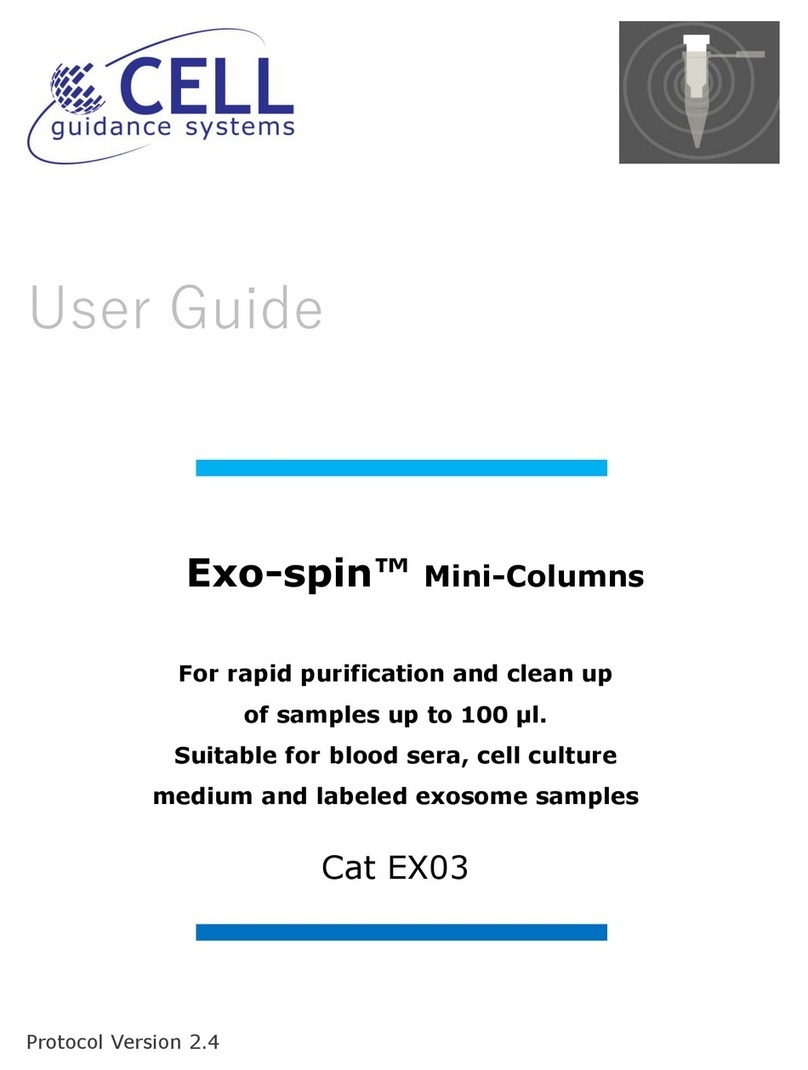
Cell Guidance Systems
Cell Guidance Systems Exo-spin Mini-Columns user guide
